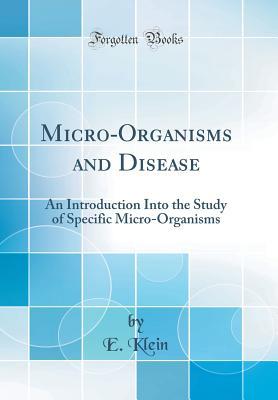Full Download Micro-Organisms and Disease: An Introduction Into the Study of Specific Micro-Organisms (Classic Reprint) - E. Klein | PDF
Related searches:
Microbes and Diseases- Explore Diseases Caused by Microorganisms
Micro-Organisms and Disease: An Introduction Into the Study of Specific Micro-Organisms (Classic Reprint)
Microbes and Diseases - Diseases Caused By Microorganisms and
Micro-organisms and disease - Micro-organisms and disease
Infectious diseases - Symptoms and causes - Mayo Clinic
Diseases and Organisms in Healthcare Settings HAI CDC
Microbes and disease - BioTopics
Microorganisms and Disease Biology Lessons 5th Grade Science
Role of microbes in human health and disease
Microorganisms and disease Flashcards Quizlet
809 3087 1466 834 3038 703 3589 4646 3161 81 1051 2263 3763 1634 2745 3096 933 2648 3493 354 4921 1968
Infectious diseases are disorders caused by organisms — such as bacteria, viruses, fungi or parasites. But under certain conditions, some organisms may cause disease.
The diseases causing microorganisms include bacteria, viruses, protozoa, fungi and a few variations of worms. Once they invade the host cell, they disrupt or damage the normal cellular activities.
Start the new year right with these organizational tips and products country living editors select each product featured.
As wal-mart and its ilk go natural, true believers are grumbling. An award-winning team of journalists, designers, and videographers who tell brand stories through fast company's distinctive lens what’s next.
Disease-causing microbes can also be called pathogens, germs or bugs and are responsible for causing infectious diseases. They can also contribute to chronic diseases and conditions, and are now being linked with coronary artery disease, diabetes, and certain types of cancer, multiple sclerosis and chronic lung disease.
Jan 3, 2021 viruses often infest prokaryotic and eukaryotic cells causing diseases.
All living organisms in the world can be classified as either an autotroph or heterotroph. An autotroph is an organism that can make its own food for energy.
This new part of the economy–people using collaborative consumption platforms to become entrepreneurs–is growing. What is inspiring these new business people? an award-winning team of journalists, designers, and videographers who tell brand.
Any micro-organism that is capable of causing disease is called a ‘pathogen’. Therefore disease producing organisms are said to be pathogenic. It is these micro-organisms that we want to kill or protect ourselves from.
I want to start making robots using micro controllers, and i want to know how to use tham, where to buy everything you need for them, and how they hook up and everything in that nature.
• microbes cause disease in the course of stealing space, nutrients, and/or living tissue from.
They are also parasites, living off their host, which does not benefit as a result.
Humorous, educational, collectible, fun! products include printed cards with fun fascinating facts; over 250 organs, cells, microbes and health products.
Examples of illnesses caused by microorganisms see the following table to know about the illnesses caused by bacteria, illnesses caused by viruses, illnesses caused by fungi.
Bacteria are found in nearly every habitat on earth, including within and on humans. Most bacteria are harmless or helpful, but some are pathogens, causing disease in humans and other animals. Bacteria are prokaryotic because their genetic material (dna) is not housed within a true nucleus.
This disease is caused due to attack of legionella bacteria that is often found in moist conditions. When people breathe in contaminated environment they often get affected by this disease. The very first case of this disease was found in philadelphia in 1976 and its symptoms are observed to be somewhat same as that of flu of pneumonia.
Find and create gamified quizzes, lessons, presentations, and flashcards for students, employees, and everyone else.
Some microbes cause disease but the majority are completely harmless.
Mar 20, 2015 in healthy sponges, microbes have been shown to account for up to 40 % of tissues.
The center for biomedical informatics and information technology (cbiit) mission is supported by several branches, programs, and offices. The center for biomedical informatics and information technology (cbiit) mission is supported by the:.
Microbes and diseases microbes are better known as microorganisms that are very tiny to be seen through naked eyes. The microbes that are harmful and capable of producing microorganism diseases also termed as pathogens. But not all the microbes are harmful and they do not cause microbial infection.
There is no shortage of microbes that cause disease; some are notable for the number of people they infect, and others for the nastiness of the infections they cause.
Klebsiella bacteria are normally found in the human intestines (where they do not cause disease). In healthcare settings, klebsiella infections commonly occur among sick patients who are receiving treatment for other conditions.
Learn vocabulary, terms, and more with flashcards, games, and other study tools.
Bacterial diseases include any type of illness caused by bacteria. Bacteria are a type of microorganism, which are tiny forms of life that can only be seen with a microscope. Other types of microorganisms include viruses, some fungi, and some parasites. Millions of bacteria normally live on the skin, in the intestines, and on the genitalia.
Learn how to get started organizing, storing and decluttering your life with free tutorials, diy projects, checklists and calendars.
Microorganisms can be, according to their characteristics, divided into several groups: bacteria, viruses, certain fungi and parasites pathogenic (capable of causing disease), non-pathogenic, and opportunistic (causing disease when they have an opportunity, like in people with low immune system).

Post Your Comments: